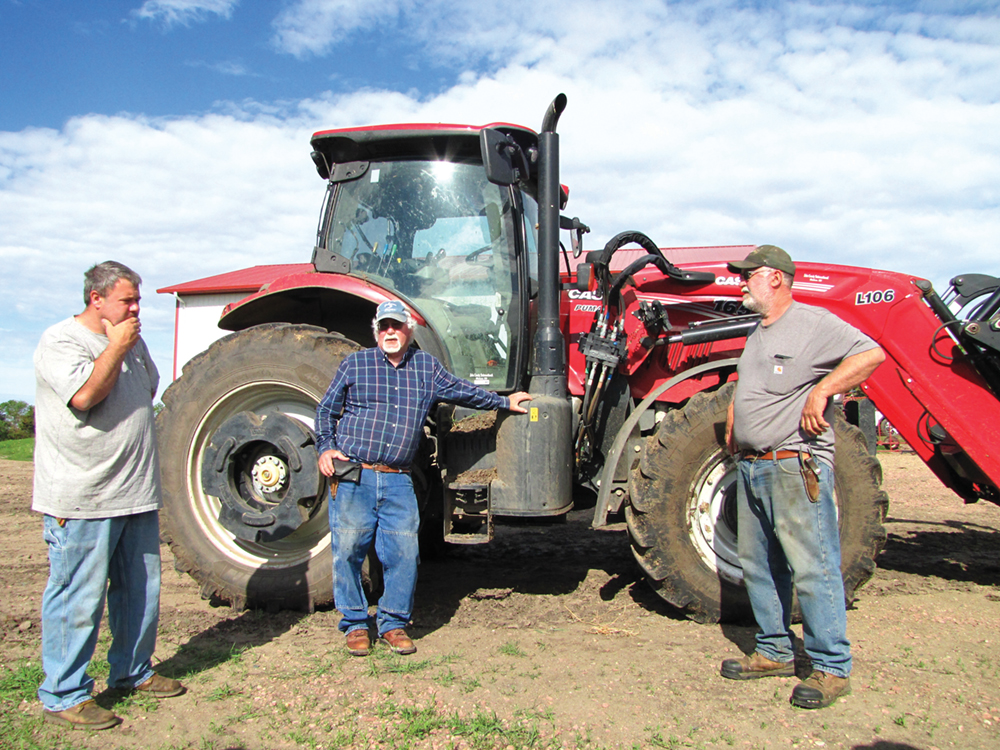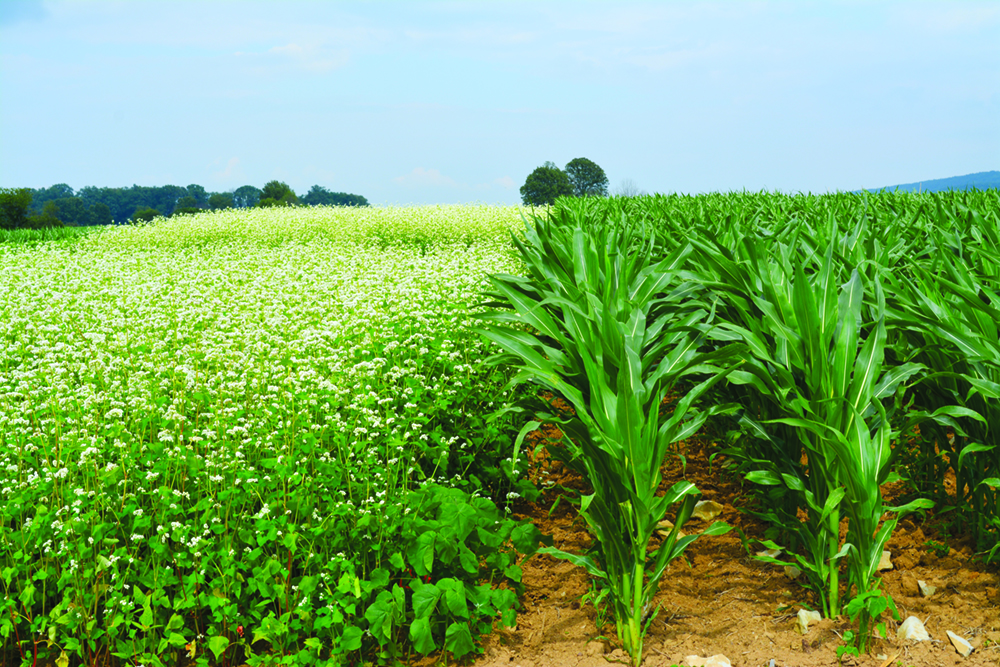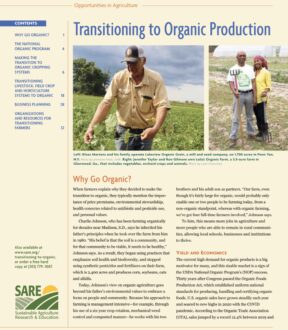When farmers explain why they decided to make the transition to organic, they typically mention the importance of price premiums, environmental stewardship, health concerns related to antibiotic and pesticide use, and personal values.

Charlie Johnson, who has been farming organically for decades near Madison, S.D., says he inherited his father’s principles when he took over the farm from him in 1980. “His belief is that the soil is a community, and for that community to be viable, it needs to be healthy,” Johnson says.
As a result, they began using practices that emphasize soil health and biodiversity, and stopped using synthetic pesticides and fertilizers on their farm, which is 2,400 acres and produces corn, soybeans, oats and alfalfa.
Today, Johnson’s view on organic agriculture goes beyond his father’s environmental values to embrace a focus on people and community. Because his approach to farming is management intensive—for example, through his use of a six-year crop rotation, mechanical weed control and composted manure—he works with his two brothers and his adult son as partners.
Our farm, even though it’s fairly large for organic, would probably only enable one or two people to be farming today, from a non-organic standpoint, whereas with organic farming, we’ve got four full-time farmers involved.
Charlie Johnson, Madison, S.D.
To him, this means more jobs in agriculture and more people who are able to remain in rural communities, allowing local schools, businesses and institutions to thrive.
Yield and Economics
The current high demand for organic products is a big motivator for many, and this sizable market is a sign of the USDA National Organic Program’s (NOP) success. Thirty years after Congress passed the Organic Foods Production Act, which established uniform national standards for producing, handling and certifying organic foods, U.S. organic sales have grown steadily each year and soared to new highs in 2020 with the COVID pandemic. According to the Organic Trade Association (OTA), sales jumped by a record 12.4% between 2019 and 2020, from $55.1 billion to $61.9 billion. It marked the first time that total sales of organic food and non-food products surpassed $60 billion.
Research shows that yields in organic systems are often lower than conventional ones, except during extreme weather situations such as drought, when they can be higher due to the healthier soils that organic practices create. However, because of strong sales and the higher prices organic products command, organic operations are usually more profitable than non-organic operations. A 2015 analysis of findings from 40 years of studies covering 55 crops across five continents found that organic agriculture was 22–35% more profitable than conventional agriculture (Crowder 2015). The analysis also found that organic operations required a breakeven price premium of only 5–7% compared to conventional, even when organic yields were 10–18% lower.
Resilience and Environmental Stewardship
Along with the economic benefits, many farmers who transition to organic are motivated by a conservation ethic. Years of research have shown that organic systems provide essential environmental benefits to humans, also known as “ecosystem services.” Examples of important ecosystem services associated with organic agriculture include:
- Soil and nutrient cycling
- Water quality protection and conservation
- Habitat to support pollinators and wildlife
- Waste decomposition and detoxification
In addition, organic farming practices may make farms and ranches more resilient to weather extremes caused by climate change, such as intense storms and drought, or extreme pest damage. This resilience and the aforementioned environmental benefits stem mainly from those organic practices that increase both biodiversity and soil organic matter. Because organic systems generally have higher soil organic matter, they tend to have better water retention, higher infiltration rates and better soil structure. The soil’s higher capacity to store and percolate water can make organic systems more resilient to ever-increasing weather fluctuations, such as floods and droughts; multiple studies have shown that in many instances organic farms do indeed outperform their conventional counterparts under severe drought conditions (Lockeretz 1981, Lotter 2003). Well-managed organic systems also have reduced soil erosion and nitrogen runoff.
Increased biodiversity at the field and landscape levels can be achieved through common organic practices such as crop rotation, conservation tillage and the inclusion of flowering plants around the farm. These practices work by providing resource-rich and disturbance-free habitat for important pollinators, beneficial insects and wildlife, which in turn provide further ecosystem services like crop pollination and pest management.
The Organic Mindset
The amount of change that will be required when transitioning to organic can vary considerably from one farmer to the next. The farming practices at the core of the NOP are rooted in agroecological practices that many individual farmers, communities and cultures around the world have passed down through many generations, including Black and Native American farmers in the United States. For farmers who already practice “organic” agriculture, the challenge of getting certified is oftentimes less about making major changes to production practices and is more a matter of adapting to regulation requirements, such as recordkeeping. Farmers from historically marginalized communities often face additional challenges, including a lack of access to financial resources, organic markets and to the NOP itself. (See the box “Seeking Equity in the Organic Industry.”)
For farmers who are currently running a more “conventional” operation—for example one that relies heavily on synthetic inputs or makes little to no use of crop rotations and biodiversity—moving toward a successful organic operation oftentimes requires a different way of thinking. This is because you have to treat your farm as an integrated system that works more in sync with nature. Plus, your ability to use non-organic farming practices and inputs becomes restricted. (See the section “The National Organic Program.”)
“In organic farming, a mind shift is essential,” says Brad Brummond, a North Dakota State University Extension agent from Walsh County, who specializes in organic production. “You must go from treating problems to treating the causes of the problems and recognizing that every decision you make will affect other aspects of your system.”
When deciding if organic farming might be right for you, Brummond offers this list of characteristics shared by successful organic farmers:
- A more focused commitment to a safer food supply and protection of the environment
- Patience and good observation skills
- Good recordkeeping habits and sound business management skills
- A deeper understanding of ecological systems
- Good marketing skills and motivation to spend time seeking out markets
- A willingness to learn from others and share stories of successes and failures
- Flexibility and eagerness to experiment with new techniques and practices
Getting Started

The most important starting point in the transition to organic certification is to become familiar with the certification process and regulations of the NOP and, as needed, find an organic consultant to assist you. All organic products must be certified by a USDA-accredited organic certification agency. Certification provides consumers the built-in assurance that the organic products they’re buying have been grown following specific standards and methods of farming. The certifier can review NOP rules and regulations with you, but it does not provide individual guidance on how to transition successfully. An organic consultant, on the other hand, can help you develop the necessary Organic System Plan (OSP) that will essentially act as your agreed upon annual contract with your certifier. Your OSP must include exhaustive details about the production and marketing practices you’ll use in your organic operation.
This publication is organized into four sections meant to introduce you to the key aspects of making a successful transition to organic:
- The National Organic Program: The principles, practices and regulations that make up the NOP
- Making the Transition to Organic Cropping Systems: The key practice areas that apply to all organic systems, such as soil and pest management
- Transitioning Livestock, Field Crop and Horticulture Systems to Organic: Important considerations based on your specific production system
- Business Planning: Strategies to prepare for the financial and personal transition
